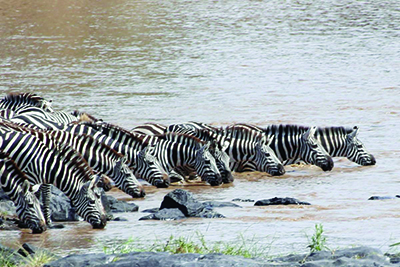The Great Migration
Rotary Club members treated to photographic safari

Rotary Club of Farragut members had a photographic safari of The Great Migration of Wildebeests and Zebras in Serengeti National Park, Tanzania, during their meeting in Fox Den Country Club Wednesday, Oct. 15.
Nature photographer/conservationist Steve Brandon led the tour as he described his recent trip to the Serengeti. RCF member Denise Bash was one of the travelers of that trip.
“I met Steve Brandon through his wife,” Bash said. “Patsy and I have known each other for at least a decade and kind of danced all around each other in professional settings.
“Earlier this year, my daughter Chloe was graduating from high school, and she wanted to go on a trip,” she said. Knowing the Brandons had been to Africa, she called them for advice. They invited Bash and her daughter to join them on their next trip.
“Every day, you get to wake up to a new day in Africa,” Steve Brandon said as he showed a photograph of a sunrise. “And, this is not uncommon. This is what you see every morning, getting up and looking out when you first wake up in the morning.
While on his trip to Serengeti National Park, they had an opportunity to experience the great migration of the wildebeests and zebras.
At the borders, “how do they handle the great migration, when they’ve got all these animals coming through?” he asked.
He showed the area has markers only every half-mile across the border, where the great migration is, so the animals can freely flow across the border.
For 365 days, “they change no less than every two weeks, from year to year, 14 days, they’ll be in the same place every year,” Brandon said. “So December-January, they’re at the bottom (in Ngorongoro Conservation Area near Lake Eyasi).
“They have their tags in February and March (in Maswa Game Reserve, below the Serengeti), then start up north (into Serengeti), by September, about a month ago,” he said. “Then, they will cross the Mara River (in Kenya) through the Masai Mara (a large national reserve in southwestern Kenya) and (travel) back down.
While crossing rivers, visitors will see the animals’ trepidation as they watch for crocodiles, waiting on the other side for their dinners.
“Occasionally, they will get out of the Serengeti Park, but they have pretty much everything in the migration now is within some national park or preserve 4.019 million acres versus our Yellowstone (Park at) 2.2 million,” Brandon said.
“Three hundred mammal species compared to Yellowstone’s 65 (species), 500 birds compared to Yellowstone’s 300 and 550,000 annual visitors compared to Yellowstone’s 4 million visitors,” he said.


